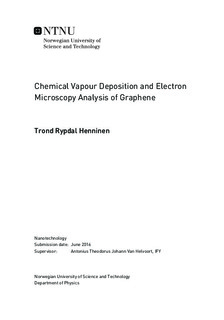Chemical Vapour Deposition and Electron Microscopy Analysis of Graphene
Master thesis
Permanent lenke
http://hdl.handle.net/11250/2402177Utgivelsesdato
2016Metadata
Vis full innførselSamlinger
- Institutt for fysikk [2695]
Sammendrag
Graphene is a promising material for many applications, including electronics, energy technologies, chemical filters and mechanical materials. In this work, graphene has been grown by chemical vapour deposition (CVD) on Cu foil. The as-grown foils were studied by scanning electron microscopy (SEM), before the Cu was etched and the graphene transferred, without the use of polymers, onto Si wafers for further SEM study. For further transmission electron microscopy (TEM) study, the graphene was instead transferred onto TEM grids. The samples were contaminated by SiO2 nanoparticles from the CVD chamber walls, and iron oxide nanoparticles from the Fe-based etch.
For rapid structural analysis, SEM was found to be highly useful at low voltage of around 1 kV. This gave high contrast of details of the upper atomic layers of the surface, enabling study of details of graphene, like wrinkles, directly on the Cu surface. Transferring onto Si wafer also proved useful, as then grain boundaries in graphene could be studied in SEM. TEM was useful for determining the thickness of the graphene. Aberration corrected TEM enabled the study of defects in the graphene, while carbon mapping of the C-k peak by electron energy loss spectroscopy (EELS) gave monolayered thickness contrast of the graphene. High-angle annular dark-field scanning transmission electron microscope (HAADF-STEM) was used with high precision energy-dispersive X-ray spectroscopy (EDX) to chemically identify the nanoparticle contaminations.
A process for growing graphene directly on Si was also attempted, by first depositing 100 nm of Cu on the Si wafer, then graphene was grown by CVD and the Cu was evaporated. However, the graphene covering the Cu limited the evaporation of Cu, making it dificult to evaporate it completely. In this process the SiO2 particles formed only on control Cu-foil samples, and were absent from the deposited Cu thin film on Si. This suggests the particles form due to unknown features of the Cu foil.
